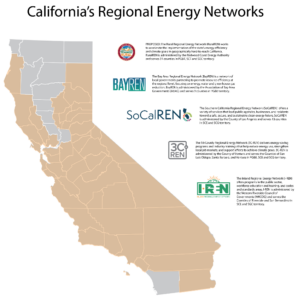November 28, 2022
Topic
With State and federal policies and budgets making record investments in climate and energy action, the California Climate and Energy Collaborative (CCEC) wanted to take a moment to reflect on the story of Regional Energy Networks (RENs), which demonstrates why taking the time to pursue grants can pay off in big ways. Through the RENs, a federal investment in the Energy Efficiency and Conservation Block Grant (EECBG) in 2010 has made a significant and continuously expanding impact on the energy efficiency program delivery landscape across California communities!
Back in 2009, responding to the need for economic stimulus, the federal government enacted the American Recovery and Reinvestment Act (ARRA), funding many programs that could support job creation, including the first allocation of the EECBG program. The next year, the DOE awarded $482 million in EECBG competitive grants to 34 recipients as part of the Better Buildings Neighborhood Program (BBNP), including awards led by Los Angeles County on behalf of partners in Southern California, the Bay Area, and other regions of the State, and Santa Barbara County. With the help of these grant awards, as well as the technical assistance and other capacity building efforts of DOE’s BBNP, these regions designed and piloted innovative and replicable approaches to cross-sector energy retrofit program delivery, outreach, incentives, financing, and workforce training. Program administrators in Los Angeles County, the Association of Bay Area Governments (ABAG), and Santa Barbara County relayed early program successes to the California Public Utility Commission (CPUC) through the Local Government Sustainable Energy Coalition (LGSEC) and obtained funds to sustain and expand these pilot programs through ratepayer dollars earmarked by the CPUC for energy efficiency. By 2012, Los Angeles County and ABAG successfully filed proposals to become a “Regional Energy Network (REN),” a new administrator of energy efficiency programs authorized by the CPUC to draw on the capacity and innovative ideas from local governments, particularly from experience gleaned during their administration of ARRA funds.
The first two RENs, SoCalREN and BayREN, launched in 2013 and continue to grow their services and reach in CA as they approach their 10 year anniversary. In 2017, Ventura, Santa Barbara, and San Luis Obispo counties successfully filed to become 3C-REN. In 2019, the REN model was authorized by the CPUC to continue administering energy efficiency programs, and new REN proposals were invited to be filed with the CPUC. A fourth REN, Inland REN (IREN), led by Western Riverside Council of Governments and partners was approved in 2021, and a fifth REN serving rural areas in the State (RuralREN) is in development.
In California, RENs are recognized by the CPUC and others for their unique ability to:
- Understand Regional Needs and Fill Gaps
- Third party programs (3PPs) are not adequately serving all communities and their energy efficiency needs
- RENs are growing and adapting to meet these gaps in 3PP programs
- Serve “hard-to-reach” Communities
- RENs can serve ratepayers that are not “attractive” to other Program Administrators (PA) and their implementers
- Provide a More Holistic Solution for Customers
- RENs can build on other PA programs to augment and supplement, not duplicate
- RENs can deliver a better EE product and better EE outcomes than the Investor Owned Utilities to meet community energy needs
The four active RENs now serve a population of over 27.5 million, including under-resourced and disadvantaged communities that do not have the capacity to administer complex energy programs alone. Each REN has developed portfolios of programs to serve their unique region and deliver on their promise to serve their communities. . The RENs are now forming a coalition to further advance innovative regional energy practices across California.
REN’s are now an integral component of the California energy efficiency landscape. Looking forward, RENs have a unique opportunity to capitalize on the REN promise and establish their essential role in the transformation to a clean energy future. – Jenny Berg, BayREN
Through RENs, California communities continue to benefit from the investments made by DOE’s first administration of EECBG dollars. This success story may be instructive as State and federal agencies consider how to deploy the second round of EECBG and a groundswell of other investments made through the Infrastructure Law, Inflation Reduction Act, and other budgetary appropriations. In particular, the story of the RENs demonstrates the value of regional collaboration and administration of community energy initiatives led by varying types of consortiums of local agencies. It serves to encourage agencies to be as flexible as possible in encouraging multi-agency consortiums to apply for and administer dollars available for community-led initiatives EECBG and other funding pathways.
CCEC hopes this case study encourages our network to act now to get “grant-ready,” so your success can move CA further towards a cleaner and more efficient energy economy for all! Stay tuned for updates on the second round of the EECBG formula and competitive grants by signing up for DOE’s listserv! And make sure to sign up for CCEC’s monthly Local Energy Resources Network (LERN) meetings to get the latest updates on relevant resources and upcoming assistance opportunities to help you actualize your community’s energy and climate goals.






